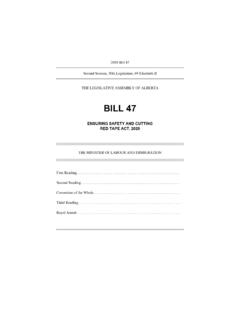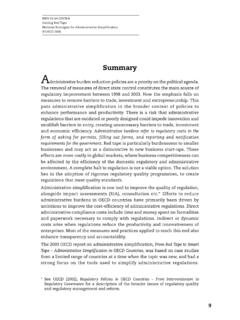Transcription of Chapter Seven: Bureaucracy and Formal Organizations
1 1 Chapter Seven: Bureaucracy and Formal Organizations Chapter Summary Society is organized to get its job done. It does so through Formal Organizations and bureaucracies. The same system that can be frustrating and impersonal is also the one on which we rely for our personal welfare and to fulfill our daily needs. The society of today, however, is not the society of yesterday, nor will it be the society of tomorrow. The rationalization of society refers to a transformation in people s thinking and behavior over the past 150 years, shifting the focus from personal relationships to efficiency and results. Karl Marx attributed this transformation to capitalism, while Max Weber, who disagreed with Marx, related it to Protestant theology. As a result of rationality, Formal Organizations secondary groups designed to achieve specific objectives have become a central feature of contemporary society.
2 With industrialization, secondary groups have become common. Today, their existence is taken for granted. They become a part of our lives at birth and seem to get more and more complex as we move through the life course. The larger the Formal organization, the more likely it will turn into a Bureaucracy . Bureaucracies are defined as Formal Organizations characterized by five features that help them reach their goals, grow, and endure. These five features are: (1) clear levels, with assignments flowing downward and accountability flowing upward; (2) a division of labor; (3) written rules; (4) written communications with records; and (5) impartiality. Although bureaucracies are the most efficient form of social organization, they can also be dysfunctional. Dysfunctions of bureaucracies can include red tape , lack of communication between units, and alienation.
3 Examples of these dysfunctions include an overly rigid interpretation of rules and the failure of members of the same organization to communicate with one another. According to Max Weber, the impersonality of bureaucracies tends to produce workers who feel detached from the organization and each other. According to Karl Marx, workers experience alienation when they lose control over their work and are cut off from the finished product of their labor. To resist alienation, workers form primary groups, band together in informal settings during the workday to offer each other support and validation. They also personalize their work space with family photographs and personal decorations. Not all workers, however, succeed in resisting alienation. One reason bureaucracies endure and are so resilient is because they tend to take on a life of their own through a process called goal displacement.
4 Once a Bureaucracy has achieved its original goals, it adopts new goals in order to perpetuate its existence. A classic example of goal displacement involves the March of Dimes. Originally founded to fight polio, the organization 2was faced with being phased out after Jonas Salk discovered the polio vaccine. Rather than disband, it adopted a new mission, fighting birth defects, and, more recently, changing the mission again to the vaguer goal of breakthroughs for babies. In addition to bureaucracies, many people in the United States become involved with voluntary Organizations , groups made up of volunteers who organize on the basis of some mutual interest. But even voluntary Organizations are not immune from the effect of bureaucratization. Although Formal Organizations provide numerous beneficial functions, they also tend to be dominated by a small, self-perpetuating elite, a phenomenon Robert Michel referred to as the iron law of oligarchy.
5 Even volunteer and non-profit Organizations are affected by the iron law of oligarchy. Sociologists use the term corporate culture to refer to an organization s traditions, values, and unwritten norms. Much of what goes on in corporate culture, however, is hidden. To ensure that the corporate culture reproduces itself at the top levels, people in positions of power groom other people they perceive to be just like them for similar positions of power. In the United States, personal achievement is central; workers are hired on the basis of what they can contribute to the organization that hires them. To counter the negative side of bureaucracies, many corporations have begun taking steps to better humanize work settings. This includes the establishment of work teams, corporate day care, employee stock ownership plans, and quality circles. There has been a great deal of research directed at comparing the Japanese corporate culture to the American corporate culture.
6 The Japanese corporate model differs significantly from the American corporate model in the way it views work, workers, and work Organizations . Although considered as superior to the American corporate culture, more recent inspection shows this to be more of a myth than a reality. Successful Japanese businesses have adopted many of the American methods. The real bottom line is that we live in a global marketplace of ideas, as well as products, with no single set of cultural values accepted as universally superior. Chapter Outline I. The Rationalization of Society A. Rationality, the acceptance of rules, efficiency, and practical results as the right way to approach human affairs, is a characteristic of industrial societies. B. Historically, the traditional orientation to life is based on the idea that the past is the best guide for the present; however, this orientation stands in the way of industrialization.
7 1. Capitalism requires a shift in people s thinking, away from the idea that This is the way we ve always done it, to Let s find the most efficient way to do it. 2. Personal relationships are replaced by impersonal, short-term contracts. 3. The bottom line becomes the primary concern. C. Marx said that the development of capitalism caused people to change their way of thinking, not the other way around. Because capitalism was more efficient, it 3produced the things in greater abundance, and it yielded high profits, people changed their ideas. D. Weber believed that religion held the key to understanding the development of capitalism. 1. He noted that capitalism emerged first in predominantly Protestant countries. 2. In The Protestant Ethic and the Spirit of Capitalism Weber proposed that a set of behaviors rooted in Protestantism led to the development of capitalist activity and the rationalization of society.
8 3. Weber argued that because of the Calvinistic belief in predestination, people wanted to show they were among the chosen of God. Financial success in life became a sign of God's approval; however, money was not to be spent on oneself. Rather, the investment of profits became an outlet for their excess money, while the success of those investments became a further sign of God's approval. 4. Because capitalism demanded rationalization (the careful calculation of practical results), traditional ways of doing things, if not efficient, must be replaced, for what counts are the results. E. No one has yet been able to establish which view is correct. Consequently, the two continue to exist side by side within sociology. II. Formal Organizations and Bureaucracies A. Formal Organizations , secondary groups designed to achieve explicit objectives, have become a central feature of contemporary life.
9 B. Early examples of Formal Organizations were guilds and the army. With industrialization, secondary groups became more common. Formal Organizations , especially as they increase in size, tend to develop into bureaucracies. C. Max Weber identified the essential characteristics of bureaucracies, which help these Organizations reach their goals, as well as grow and endure. These include the following: 1. a hierarchy where assignments flow downward and accountability flows upward. 2. a division of labor. 3. written rules. 4. written communications and records. 5. impersonality. D. Weber's characteristics of Bureaucracy describe an ideal type a composite of characteristics based on many specific examples. The real nature of Bureaucracy often differs from its ideal image. E. Weber's model only accounts for part of the characteristics of bureaucracies.
10 Dysfunctions can also be identified. 1. Red tape , or the strict adherence to rules, results in nothing getting accomplished. 2. A lack of communication between units means that they are sometimes working at cross purposes; sometimes one unit undoes what another unit has accomplished because the two fail to inform one another what each is doing. 43. Bureaucratic alienation, a feeling of powerlessness and normlessness, occurs when workers are assigned to repetitive tasks in order for the corporation to achieve efficient production, thereby cutting them off from the product of one's labor. 4. To resist alienation, workers form primary groups within the larger secondary organization, relating to one another not just as workers, but as people who value one another. 5. The alienated bureaucrat is one who feels trapped in the job, does not take initiative, will not do anything beyond what she or he is absolutely required to do, and uses rules to justify doing as little as possible.



















